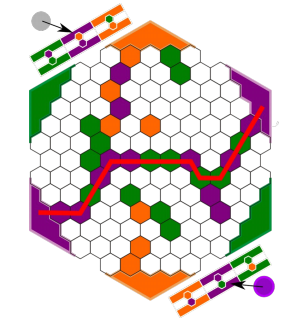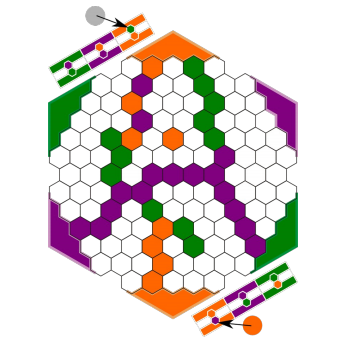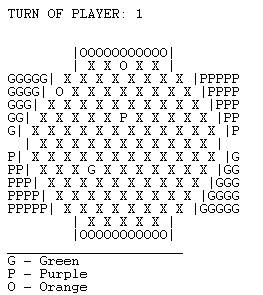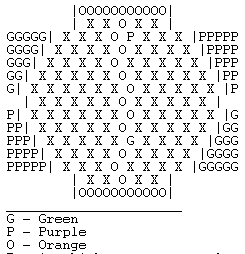| Name | Number | |
|---|---|---|
| Adriana Cruz e Silva da Costa Gonçalves | 201808911 | up201808911@fe.up.pt |
| José António Dantas Macedo | 201705226 | up201705226@fe.up.pt |
Put all files with extension '.pl' in the same folder
Start Sicstus Prolog (or another Prolog development environment compatible with Sicstus and the ISO standard)
Consult / import the file 'alliances.pl' <consult (' path / to / file / alliances.pl ')>
Call the play/0 function by typing the command 'play.'
Follow the game instructions
Alliances, a 2-player game by Markus Hagenauer.
Alliances is a tricky game that requires you to connect opposite sides of
the board.
The board has a shape of a 7x7 hexagon without the edges.
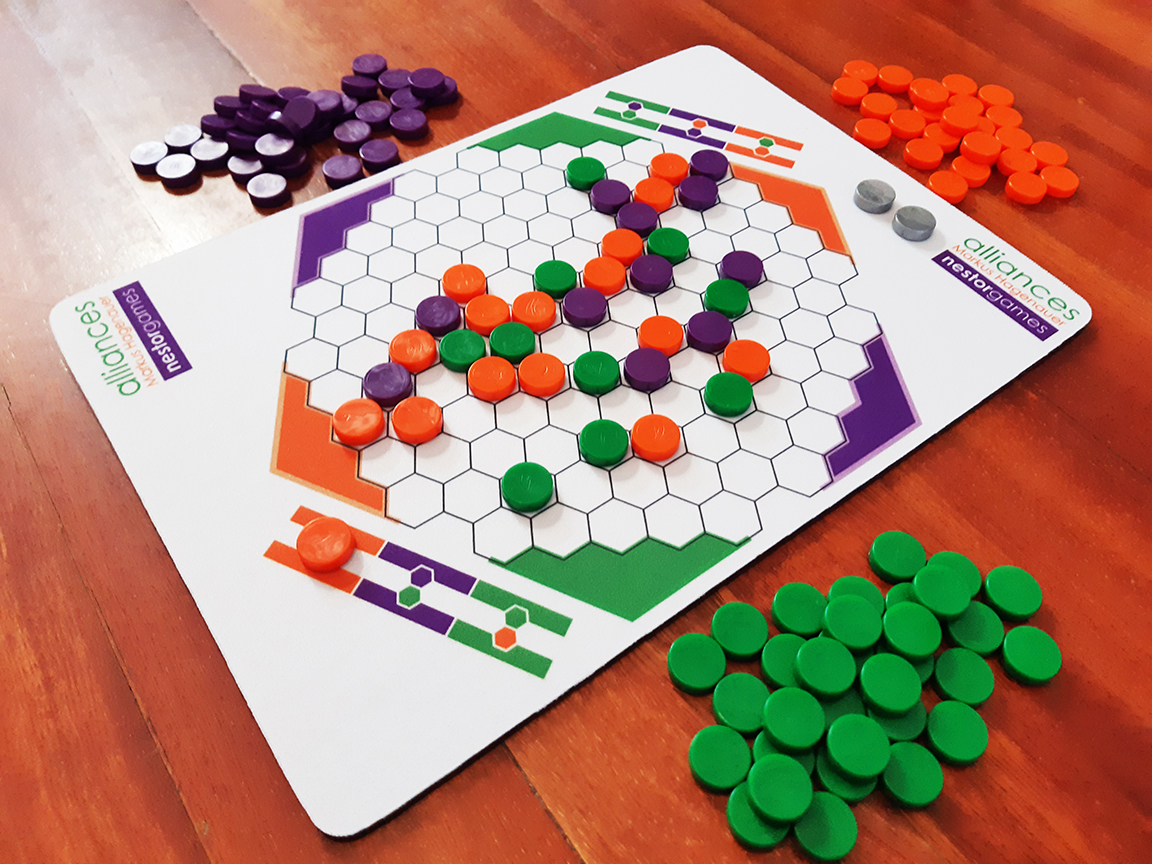
To connect opposite sides of the board,
each player must use the color matching the sides and form an
uninterrupted chain of discs between those sides.
The chain of discs can also be formed by the allied colors, which is different for each player:

1 gameboard, 42 green discs, 42 orange discs, 42 purple discs, 2 silver discs
Every turn a player takes a disc from the supply and places it on any empty space on the board.
If a connection is made between opposite sides,
with an uninterrupted chain of discs of the sides' color and/or the allied colour,
the player wins the color of the connected sides.
Win 2 colors. A player wins a color by being the first to connect its two sides on the board or if a move makes it impossible for either player to connect a particular color (by fencing it off), then the blocked player's opponent wins that color.
You can find a more explanation
here
or find it online:
https://nestorgames.com/rulebooks/ALLIANCES_EN.pdf;
https://boardgamegeek.com/boardgame/302399/alliances;
gameplay video:
https://www.youtube.com/watch?v=VNyHiCfOWhw&feature=emb_logo.
Program starts by calling the predicate play/0, in which the initial menu is displayed calling display_main_menu/0. According to the selected game mode, the predicate that will fill the state of the game will be called (display_game/2 or display_game_computer/2 or display_game_computer_PC_only/2) .
The current state of the game is stored in a list of lists with differents lengths.
The list represents the board, and the lists within that list represents the different rows of the board.
The rows of the board have multiple atoms that represent the discs and the empty spaces of the board.
Atoms meaning:
| Atom | Meaning |
|---|---|
| X | Empty space on the board |
| G | Green Disc |
| P | Purple Disc |
| O | Orange Disc |
Current Player is represented by the variable 'Player'.
Exemple of representation of game states:
Example of initial board:
initial([
['X','X','X','X','X'],
['X','X','X','X','X','X','X','X'],
['X','X','X','X','X','X','X','X','X'],
['X','X','X','X','X','X','X','X','X','X'],
['X','X','X','X','X','X','X','X','X','X','X'],
['X','X','X','X','X','X','X','X','X','X','X','X'],
['X','X','X','X','X','X','X','X','X','X','X'],
['X','X','X','X','X','X','X','X','X','X','X','X'],
['X','X','X','X','X','X','X','X','X','X','X'],
['X','X','X','X','X','X','X','X','X','X'],
['X','X','X','X','X','X','X','X','X'],
['X','X','X','X','X','X','X','X'],
['X','X','X','X','X']
]).
Example of intermediate board:
intermediate_board([
['X','X','X','O','X'],
['X','X','X','X','X','X','X','X'],
['X','X','X','X','X','X','X','X','X'],
['X','X','X','X','X','X','X','X','X','X'],
['O','X','X','X','X','X','X','X','X','X','X'],
['X','X','X','X','X','X','X','X','X','X','X','X'],
['X','X','X','X','X','G','X','X','X','P','X'],
['X','X','X','X','X','X','X','X','X','X','X','X'],
['X','X','P','X','X','X','X','X','X','X','X'],
['X','X','X','X','X','X','X','X','X','X'],
['X','X','X','X','X','X','X','X','X'],
['X','X','X','X','X','X','X','X'],
['X','X','X','X','X']
]).
Example of final board:
final_board([
['X','X','O','X','X'],
['X','X','X','O','X','X','X','X'],
['X','X','X','O','X','X','X','X','X'],
['X','X','O','X','X','X','X','X','X','X'],
['X','X','X','O','X','X','X','X','X','X','X'],
['X','X','X','X','O','X','X','X','X','X','X','X'],
['X','X','X','O','X','X','X','X','X','X','X'],
['X','X','X','O','X','X','X','X','X','X','X','X'],
['X','X','X','O','X','X','X','X','X','X','X'],
['X','X','X','X','O','X','X','X','X','X'],
['X','X','X','O','X','X','X','X','X'],
['X','X','X','O','X','X','X','X'],
['X','X','O','X','X']
]).
The predicate of the game state visualization was implemented by calling the predicate initial that returns the variable 'Board' with the initial game state (empty board).
Then the predicate random_select selects a random player to start and returns the variable 'Player',
the predicate display_game is then called with the variables 'Board' and 'Player' and calls the predicate display_board that calls several predicates that will write the game state.
Here's an example of the game state visualization:
Emply Board of Alliances:
Intermediate Board of Alliances:
Final Board of Alliances:
After displaying the board game, the player can choose a position to play a certain piece, by choosing in which row and row position he wants to play, and the predicate valid_move/6 will check if its valid to place the piece on that position. If the chosen position isn't valid, there will be a message on screen informing the player that the position is already occupied and the player will be asked to pick a different position. If the piece can be placed there, meaning if the position the player chose is an empty position 'X', the predicate move/5 will be called and will place the chosen piece on the chosen position.
After calling the predicate display_game_computer_PC_only/2 or display_game_computer/2, auxiliar functions are used to determine where the PC will play and the predicate valid_move/6 will validade that move or not, by checking if the position is empty.
In this project we implemented the board game Alliances was developed in Prolog language using the development system Sicstus. It's playable by Human vs Human, PC vs PC and Human vs PC. We believe we achieved some of the main goals of this project, however due to time constraints we were not able to debug the many functions created to verify the win conditions. We also didn't implement the level of difficulties for the PC mode, meaning the PC always plays on the same level. Despite not having been able to finish the implementation of those features we believe the final project still allows the players to have a similar experience to playing the real board game from which this game was inspired.
